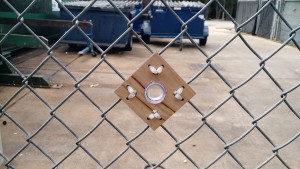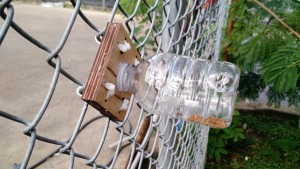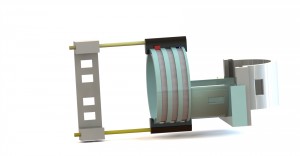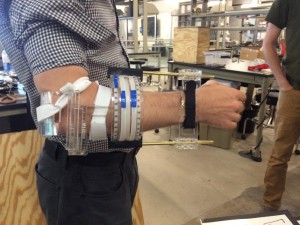To start the week off, we wrapped up our engineering design boot camp and concluded out anteater projects… for now. As it turns out, our prototypes exceeded expectations and they might be tested at the zoo in the near future. I loved the design we came up with on our team: a simple plate attachment for the fence where a bottle can be screwed in.
The first picture shows just the plate attachment on the fence. It is laser cut out of plywood and zip-tied to the fence wire. In the middle sits a bottle cap which has a hole cut through it to allow for the anteater’s tongue. In the picture on the right, the bottle is screwed in with food, demonstrating the setup for feeding the anteaters.
My favorite aspect of the design is its simplicity, exemplifying KISS (keep it simple, stupid). The fabrication is very low cost and it accommodates an everyday plastic bottle, something the zoo can easily replace. Still, it brings the anteaters to the front of the exhibit and showcases their tongues through the transparent plastic. I am really excited to see how the prototype tests at the Houston Zoo!
On Thursday, we also found out our teams and projects for the summer! I’m looking forward to designing a forearm rotation device alongside Jeremy and Hillary. Our project is a continuation of a previous ENGI 120 and 200 project from the 2014-15 school year. The objective is to design a device for Shiners Hospital which measures forearm rotation, specifically meant for patients recovering from surgery or with physical disabilities. Limitations in the current device include lack of accuracy, the inability to isolate just the forearm rotation, and the inability to easily accommodate patients with a variety of physical limitations.
We will be heavily building off the previous solution proposed by the earlier ENGI 120 and 200 team. The design is shown below.
This design addresses the problem via a mechanical solution in which markers along the cuff rotate out with the wrist and measure the degrees of rotation. Although we don’t have the prototype from the previous team, we know that flaws with the design included too much friction and some issues with accommodating a variety of physical limitations.
To finish the week off, we started rebuilding the old prototype from the team’s CAD files. As we move into next week, we are planning on assessing the prototype and moving on to improving it through the engineering design process.



